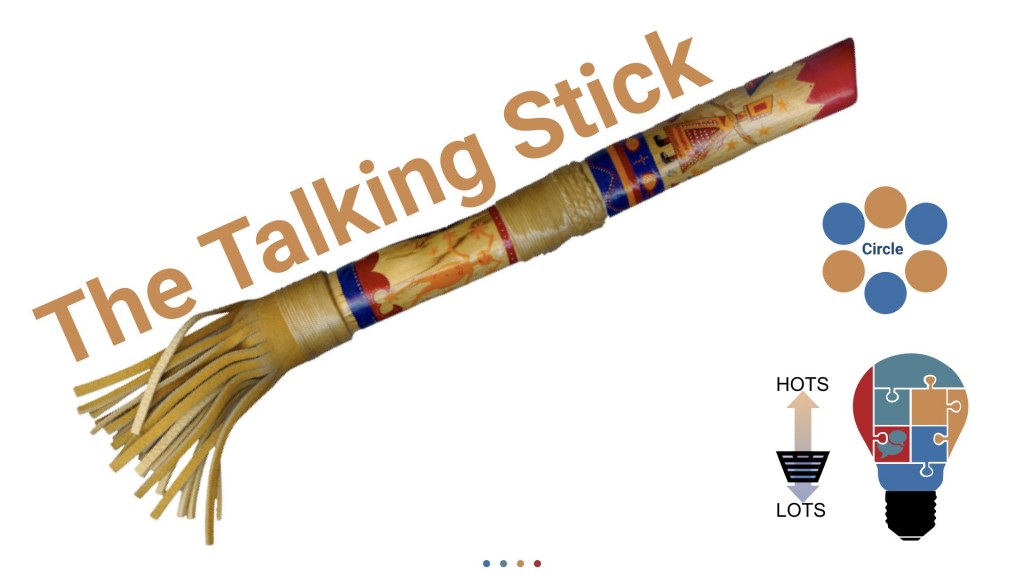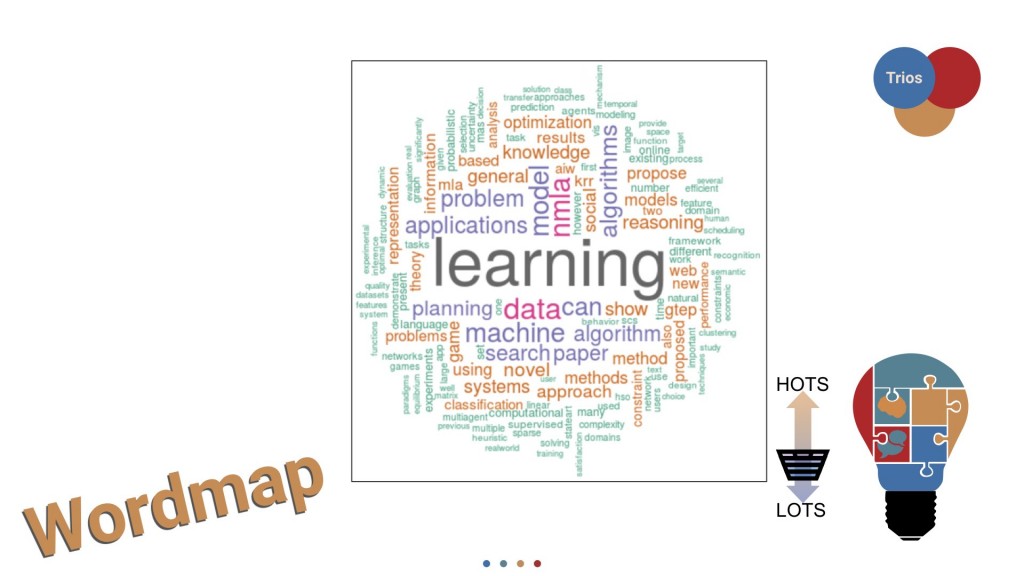Three Participatory Learning Activities for Lower Order Thinking Skills (3 LOTS PLAs)
In the TOP 10 PARTICIPATORY LEARNING ACTIVITIES (PLAs) series, I described, in brief, ten configurable and reusable PLAs that you can employ in your practice. Their flexibility in design makes all of them ideal for your expanding toolbox to offer more active learning in your courses, and can also be adapted easily to the online environment.
This post, and another earlier this month, are two more supplemental blog posts, each containing an additional three PLAs that focus more on the Bloom’s Taxonomy (BT) (Bloom, 1956; Anderson & Krathwohl, 2001) distinction between the higher order thinking skills (HOTS – apply, analyse, evaluate, create) and the lower order thinking skills (LOTS – remember, understand). Remember to keep in mind that moving from HOTS to LOTS is a continuum, as represented by the vertical arrow as lever moving up and down as appropriate. Let’s have a look today at three HOTS PLAs.
LOTS 1. Hot Seat
Hot seat puts the pressure on a single learner, yet still involves the rest of the class. If you can imagine this activity in a physical classroom, one student is chosen to sit in the Hot Seat in the center of the classroom, surrounded by classmates. Classmates’ questions and queries are directed to the Hot Seat occupant, who must answer in whatever configuration you decide. Perhaps you are reviewing concepts, giving definitions, helping to recall information, guessing new vocabulary words related to the topic. The point is, only the person in the hot seat is allowed to give the answer, while everyone else is tasked with asking the questions. While this sounds stressful for the person in the Hot Seat, it’s actually more fun and involving than you might initially think.
There are many applications. This YouTube video explains using Hot Seat For teaching English as a Second Language, but what they describe can easily be adapted for most subjects where review of materials and concepts becomes essential.
LOTS 2. The Talking Stick
In many Native American cultures in the Northwestern United States and Western Canada, the Talking Stick is used to control a conversation. Only the person holding the stick may speak.
This can be recreated in a group to ensure that everyone gets a chance to say something, and that the conversation is done one person at a time. This is a good way to encourage self-regulatory learning to practice the leadership skill of deep listening.
In an online environment, all group members must adhere to giving all other members a chance to speak uninterrupted when discussing new ideas, recalling information, brainstorming solutions to problems posed, and many other scenarios that you can devise.
HOTS 3. Wordmap
Kahoot! has a tool called “Open-Ended Question” that automatically generates a “word map” of whatever game participants’ input. The most frequent single words appear larger than the other words in the generated product.
The applications for this are many, but the generated map leaves an instant visual to varied responses from students. Words input can be in response to any question that requires memory recall, so the tool in Kahoot! is ideal for quick review of terms, definitions, or correct spelling, just to name a few of the simpler applications.
Wordle is a web-based solution, and has options to download dedicated software for MacOS and Windows OS.
This is a supplemental installment, in two additional parts, to the Top Ten Participatory Learning Activities (PLAs) Series, published in the Winter 2019-2020 term. Each week, Dr. Larry Davies described PLAs that are effective to use online. Your use of these PLAs will foster better learning and higher motivation in your learners. Each PLA contains an illustration that contains four elements:
- The name of the activity.
- Which one of the four types the activity is (that’s the lightbulb), including,
- Creative/critical thinking activity (inside the lightbulb, top left – the brain);
- Small group conversational activity (bottom left – the speech bubbles);
- Exit activity (given at the end of a lesson, unit, or project) (top right – the exit sign);
- Timed activity (where learners are under pressure to complete it within minutes) (bottom left – the clock).
- Whether it’s a Higher or Lower Order Thinking Skills Activity (HOTS or LOTS) (the HOTS/LOTS lever with “the pail”).
- A suggested grouping to maximize the benefit of the activity (the circles arranged in many ways).
Also, the description contained suggestions for one or more online tools you can use with the PLA.
Previous blogs in this series include:
- PLAs #10 – The Empty Quarter
- PLAS #9 – Mindmap
- PLAs #8 – One Word
- PLAs #7 – Exit Ticket
- PLA #6 – Brainstorm
- PLA #5 – One-Minute Essay
- PLA #4 – Think-Pair-Share
- PLA #3 – CheckPoint
- PLA #2 – Gallery Walk
- PLA #1 – The KWL (and the KWHLAQ)
- 3 HOTS PLAS
References
Anderson, L. W., & Krathwohl, D. R. (2001). A taxonomy for learning, teaching, and assessing: A revision of Bloom’s taxonomy of educational objectives. New York: Longman.
Bloom, B. S. (1956). Taxonomy of educational objectives: The classification of educational goals. New York: Longman.
De Bono, E. (1982). Plus, Minus, Interesting: Weighing the Pros and Cons of a Decision, De Bono’s Thinking Course.
http://www.mindtools.com/pages/article/newTED_05.htm
Subscribe to our Newsletter
Recent Posts
Teaching infographics #2 – VOCAL: Traits of a Successful Online Teacher
This graphic is a quick guide for some common s...10 routines for teaching online – #4 Talk types
The idea of ‘talk types’ is loosely...
Differentiating Instruction in Your LMS
Anyone who has been in the world of education f...
Authors
- Andy Steele (9)
- Azim Ahmed (12)
- Christine Lampe (3)
- Gemma Escott (1)
- Larry Davies (25)
- Mahinour Ezzat (1)
- Raghad Nihlawi (16)
- Samantha McDonald Amara (16)
- Sarah Whittaker (55)
- Silishi Noushad (1)
Categories
- Adult Learning
- Assessment
- Blackboard
- Blackboard
- BookWidgets
- Collaborate Ultra
- Ed Tech
- Grade Center
- ILC
- Infographics
- Instruction
- Learning Technology Tools
- Microsoft
- Mobile OS
- Mobile Technology
- Nearpod
- News & Events
- PLAs
- Professional Development
- Routines
- Teaching with Technology
- Uncategorized
- Webinars
Tag Cloud
Archives
- February 2021
- November 2020
- October 2020
- September 2020
- August 2020
- July 2020
- June 2020
- May 2020
- April 2020
- March 2020
- February 2020
- January 2020
- December 2019
- November 2019
- October 2019
- September 2019
- August 2019
- June 2019
- May 2019
- April 2019
- March 2019
- February 2019
- March 2016
- January 2016
- November 2015
- October 2015
- June 2015
- May 2015
- March 2015
- February 2015
- January 2015
- November 2014
- October 2014
- September 2014
- August 2014
- June 2014
- May 2014
- April 2014
- March 2014
- February 2014
- January 2014
- September 2013
- January 2013
- December 2012
- November 2012
- October 2012
- July 2012
- April 2012
- March 2012


